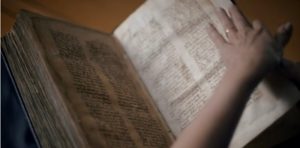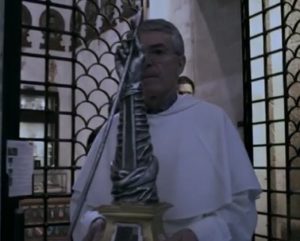Season 2 of CNN’s Finding Jesus: Faith, Fact, and Forgery had far fewer references to Christian apocrypha than season 1, and so there has been little reason to mention the series here (click HEREfor reviews of last season). Episode six, however, is devoted to the apostle Thomas and features an extended discussion of the Acts of Thomas.
 The episode traces the origins of the Thomas Christians who live in Kerala, on the southwest coast of India. They believe their church was established through evangelization by Thomas in the first century. Along with appealing to the Acts of Thomas as a (partly) historical document, the episode attempts to verify the Thomas Christians’ claim by examining a relic of Thomas now residing in Italy.
The episode traces the origins of the Thomas Christians who live in Kerala, on the southwest coast of India. They believe their church was established through evangelization by Thomas in the first century. Along with appealing to the Acts of Thomas as a (partly) historical document, the episode attempts to verify the Thomas Christians’ claim by examining a relic of Thomas now residing in Italy.
The episode opens with a re-enactment and discussion of the story of “doubting Thomas” from John 20:24-29. The re-enactments this season have been liberally embroidered, and this one is no exception. Here Peter asks Thomas where he was. “Away,” Thomas answers. Then Peter says, “Thomas. So little faith.” Thomas sullenly responds with, “It’s over.” The panel of scholars then speculate about Thomas’s doubt and absence from the group , with Candida Moss suggesting, “Perhaps he felt they should break up. Perhaps he decided to grieve privately.” Of course, the text is silent. John simply says he “was not with them when Jesus came.” He could have been fetching bread and wine. The scene continues with the apostles performing the Eucharist meal. Then Jesus appears in a blinding light but only Thomas sees him. In the Gospel, however, Jesus seems to appear to everybody in the room (it says only “Jesus came and stood among them”). My point here is not to fault the filmmakers—they simply want to make the scene come alive for the audience. What is interesting is that their re-enactment has become an apocryphal telling of the Thomas story, with expansions and interpretations just as we see in ancient apocrypha.
Ben Witherington and Mark Goodacre remark that, after the appearance of Jesus in the room, Thomas vanishes from the New Testament. Unless, of course, one counts the letter attributed to Jude, “the brother of James,” and presumably, the brother of Jesus mentioned in Mark 6:3 and Matt 12:55-56. But that identification is only possible through the tradition that Thomas’s true name is Judas, as recorded in the Gospel of Thomas, the Acts of Thomas, the Book of Thomas, and the Syriac translation of John 14:22. Nevertheless, the scholars are correct that the New Testament does not report anything about Thomas’s evangelizing activities. But they are documented in great detail in the Acts of Thomas.
 Nicola Denzey Lewis examines the British Library manuscript.
Nicola Denzey Lewis examines the British Library manuscript.The episode cuts to Nicola Denzey Lewis in the British Library examining a Syriac manuscript of the text, presumably BM Add. 14645 copied in 936 CE. An earlier copy exists, a palimpsest at Sinai (Codex 30) from the fifth or sixth century, but this one is certainly less accessible than the British Library manuscript. Of this copy, Denzey Lewis says, “The text is written in Syriac and that’s significant because it’s very closely related to Aramaic and Aramaic is the language that Jesus spoke to his disciples.” The suggestion is that the text thus has a claim to authenticity, more than, presumably, a text in Greek or Latin. Indeed, likely the Acts of Thomas was written in Syriac—a rare case of early Syriac composition for an apocryphal text, or any Christian text for that matter. But the language of composition, particularly for a late second or early third century text, doesn’t have any impact on the authenticity of what the text reports.
The episode continues with a re-enactment of the Great Commission in which the apostles draw lots to determine where they will evangelize. This event is reported in Acts of Thomas 1, but it is a widespread tradition that appears in several other texts, including Origen’s Commentary on Genesis: “The holy apostles and disciples of our Savior were scattered over the whole world. Thomas, tradition tells us, was chosen for Parthia, Andrew for Scythia, John for Asia, where he remained till his death at Ephesus. Peter seems to have preached in Pontus, Galatia and Bithynia, Cappadocia and Asia, to the Jews of the Dispersion. Finally he came to Rome where he was crucified, head downwards at his own request. What need be said of Paul, who from Jerusalem as far as Illyricum preached in all its fullness the gospel of Christ, and later was martyred in Rome under Nero?” (quoted in Eusebius, Ecclesiastical History 3.1). In the Acts of Thomas, Thomas draws India and initially refuses to go, fearing that the Indians would not understand him. The narrator says, “After a night of prayer, Thomas accepts his lot.” Then Thomas tells a radiant Jesus, “I’ll go wherever you wish.” The episode leaves out a key component of the story. After Thomas’s refusal, Jesus sells Thomas as a slave to a merchant from India named Chaban (Acts Thomas 2). Thomas does pray on the following night, but his statement to Jesus is more an acquiescence to his fate than an acceptance of the results of the lot.
When Thomas arrives in India he makes contact with the King Gundafar and we are told by the filmmakers that this element of the story has some historical verisimilitude. Denzey Lewis is once again depicted in London, this time at the British Museum examining a coin of Gundafar discovered in the 19th century. Mind you, Gundafar ruled over Parthia, the location of Thomas’s missionary activities according to Origen, not India.
 The arm of Thomas in Bari, Italy.
The arm of Thomas in Bari, Italy.In the final re-enactment, Thomas is killed by a group of soldiers. According to the Acts of Thomas, the apostle’s body is placed in a tomb “ where the kings of old used to be buried” (168), but is later taken “to the western regions” (169). Ephrem (d. 377) and Gregory of Tours (583-594) both place Thomas’s remains in Edessa. From there they were apparently taken in 1258 to Ortona in Italy, where they now reside in the Basilia di San Tommaso. At this point in Finding Jesus, the investigation turns to Georges Kazan and Tom Higham, a team from Oxford who travel the world to examine relics and determine their origins and movement over time. They take another Thomas relic, an arm bone of the apostle housed in Bari, Italy, and submit it to radio carbon tests. The goal, Kazan says, is to see what it can tell us about the legends of Thomas: “A first-century date will potentially open the door towards validating that Jesus went to India.” Of course, no amount of scientific testing can do that much; at best, it can prove that the bone is from a man, any man, who lived in the first century. As it turns out, it cannot even prove that. The relic dates from 130-330 which, Higham says, “is still incredibly old” and “seems to cover the period where we find the first historical references to his remains coming back from India.” Presumably, Higham is referring here to Ephrem and is suggesting that the remains of Thomas known to Ephrem were instead of someone close to his own time
Despite these speculations, embroideries, and infelicities, the episode draws the viewers’ attention to a text that is little known by the wider public. There are now many, many documentaries that feature explorations of apocryphal texts, but only one other focuses on the Acts of Thomas: National Geographic’s Deadly Journeys of the Apostles episode 4 (watch it HERE), which covers much of the same ground as the CNN documentary, but without the dodgy interest in relics. Finding Jesus is a welcome addition to the pedagogical resources available to those of us who teach about Christian apocrypha, Syriac Christianity, and late antiquity.
